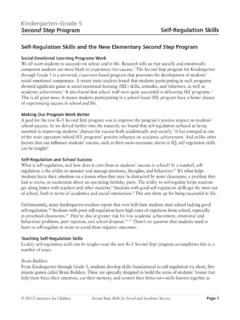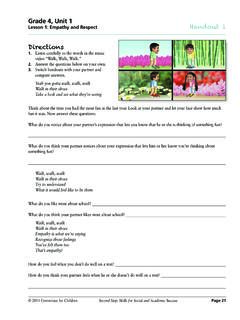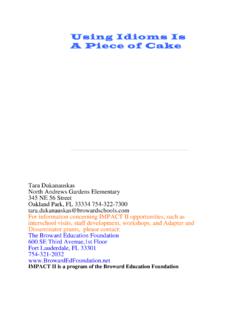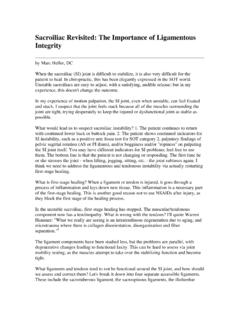Transcription of Purpose of This Guide - Second Step
1 Kindergarten Grade 5 Second Step Evaluation Guide1 2017 Committee for ChildrenPurpose of this Guide this Guide is written specifically for people who want to evaluate a school or district s implementation of the Second Step program, but are not trained in program evaluation and are not working with a professional isn t a general Guide to evaluating school-based programs it s written specifically with the Second Step program in mind. Why Evaluate? People evaluate their use of the Second Step program for a variety of reasons. In general the goal is to show that the resources put into the program are paying off, so one of the most common audiences for evaluations is funders. Another important audience is parents and community people choose to evaluate the program to see how it s working. Evaluation evidence can increase staff motivation and commitment to implementing the program fully and well.
2 Evaluation can also help schools see how implementation might be affecting outcomes and how it might be improved to ensure students are benefitting fully from the program. Evaluation is also useful for tracking progress toward desired program goals and outcomes over time. Evaluating Implementation What Am I Evaluating? One of the keys to successful, effective evaluation is to be sure you know just what you re evaluating. Every school and district purchases the same Second Step program, but what students actually receive can vary widely. You can make your Second Step evaluation more powerful and useful by looking at how the program is being implemented in your school or district. Remember, you re evaluating the intervention your students actually get, which, depending on implementation, might be more or less like the exact program you purchased. What Information Should I Gather?
3 What would a school need to know to be able to include implementation in its evaluation? Assessing implementation primarily means gathering information on how the Second Step program is being taught in your setting or settings. In particular: How many students are receiving Second Step lessons? All students? Only certain grades? Only certain classrooms? How many of the lessons are being taught? How closely are lessons being taught to how they are written? Are students doing Daily Practice Activities? What else is being done outside formal lessons to reinforce Second Step skills, both in the classroom and throughout the school?How Do I Gather It? Collecting data on what students are receiving typically involves having staff complete a simple survey that asks the questions listed above. Some surveys for this Purpose are available on : The Implementation Preparedness Survey assesses implementation readiness, whether for support purposes or for checking back later on possible implementation problem sources The Lesson-Completion Checklists for teachers and counselors are short surveys for assessing implementation of the entire program post-implementation and cover dose, fidelity, and reinforcement The Implementation Survey briefly covers the full range of implementation readiness and actual implementationSurveys should be filled out by the relevant staff.
4 For example, in some schools the program is taught by classroom teachers, while in others counselors teach most of the lessons. However, teacher input will always be required to find out how much and what parts of the Second Step program students are actually getting, since teachers are responsible for skill reinforcement outside the lessons, even when the lessons are taught by counselors. What s Implementation Fidelity? Surveying staff on how the program is being taught can also go beyond examining how many students are receiving how many lessons. Implementation evaluation Kindergarten Grade 5 Second Step Evaluation Guide2 2017 Committee for Childrencan also look at the fidelity of implementation. Fidelity basically means the extent to which the program is taught as full implementation ideally means students are receiving all the lessons in order and all the content in each lesson.
5 For a variety of reasons, staff sometimes only teach parts of lessons and skip others, teach lessons out of order, or change some of the content. These are all examples of low fidelity. Obviously it s possible to change lessons in ways that don t harm or might even improve outcomes, but it s also possible to change lessons in ways that reduce program effectiveness. Committee for Children recommends implementing the program with as much fidelity as possible, and it can be useful in an evaluation to know the fidelity with which the program was taught. Types of Evaluation Design It might be helpful to think about your Second Step evaluation as falling somewhere along a spectrum of evaluation rigor. The most rigorous approach is an experimental design, in the middle is what is called quasi-experimental design, and the least rigorous approach is a non-experimental design.
6 Each of these designs and their pros and cons are described below. Experimental Design One of the main challenges in program evaluation is determining whether any effects you find were in fact caused by the program you re evaluating. In any given classroom, school, or district, the Second Step program is only one of many factors affecting students attitudes and behaviors. The Purpose of an experimental design is to increase your confidence that changes you find in students were caused by their exposure to the Second Step is primarily accomplished through random assignment. Random assignment means you determine which students will be involved in the study (your study population), and each of those students has an equal chance of either being taught the program or not. Random assignment is a powerful way to create two groups that are as likely as possible not to be significantly different.
7 this goes a long way toward ruling out differences in outcomes being due to initial differences in the students being studied. For complicated technical reasons, random assignment for evaluating a program like the Second Step curriculum requires assigning entire schools to either implement the program or not (the ones that don t implement serve as non-intervention controls). In addition, for statistical reasons, a large number of schools must be involved in the evaluation. Scientifically valid experimental design evaluations of the Second Step program commonly involve thirty to sixty or more schools in one study. A study this large is typically not feasible for a school district to carry out, and since experimental design requires randomizing entire schools, this approach cannot be done by an individual school. Quasi-Experimental Design Quasi-experimental designs are a way to try to assess program effects when random assignment isn t possible.
8 Rather than a randomly selected control group, a quasi-experimental design includes a comparison group. Comparison groups are made up of students who are not receiving the program. The key to creating a good comparison group is attempting to match the students as closely as possible to those receiving Second Step lessons. The more alike the two groups are, the more useful the comparison group data will be. The most common way to match comparison group students (or classrooms or schools) to those getting Second Step lessons is by using demographics, such as age, race or ethnicity, gender, income, etc. The drawback to the quasi-experimental approach is you ultimately have less certainty that the students in the two groups you re comparing are alike to begin with than with random assignment, and differences between the two groups that don t have to do with the Second Step program may be part of the cause of differences you find in outcomes.
9 However, this approach is a reasonable way to increase the strength of an Design A non-experimental design means gathering data on children who receive the Second Step program only, without any control or comparison children involved. this approach is often the most feasible for many schools and districts. Just keep in mind that it can t tell you whether any outcomes you find were actually caused by the Second Step program. this method gives you relational findings that tell you how related your outcomes are to the Second Step program, but not what is causing that relationship. For example, it may be that the Kindergarten Grade 5 Second Step Evaluation Guide3 2017 Committee for ChildrenSecond Step program is causing the changes you find, or it could be that schools using the Second Step program are also doing other things that benefit children and cause the changes you re finding.
10 The clear advantage of not including control or comparison groups in your evaluation is that it s simpler and relatively primary approach used in non-experimental Second Step evaluation is to collect data before and after the program is implemented. this information is often called pre- and post-test data. Getting this information typically involves surveying students and/or staff in the fall and again in the spring. Although it s difficult to know how much of the change (positive or negative) from fall to spring was caused by the Second Step program, there are ways to make this evaluation approach stronger and more informative. Keep in mind that student behavior typically changes from the beginning to the end of the school year, regardless of what programs you re implementing. The simple pre/post evaluation approach can be tricky, because students often start the school year out on their best behavior, but by the end of the year their behavior can look worse than they did at the beginning even if you implement the Second Step program and it s working.







